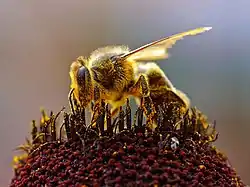蜂
| ||||||||
Translingual
Han character
蜂 (Kangxi radical 142, 虫+7, 13 strokes, cangjie input 中戈竹水十 (LIHEJ), four-corner 57154, composition ⿰虫夆)
Derived characters
- 𦾌
References
- KangXi: page 1084, character 6
- Dai Kanwa Jiten: character 33088
- Dae Jaweon: page 1551, character 23
- Hanyu Da Zidian (first edition): volume 4, page 2857, character 7
- Unihan data for U+8702
Chinese
| simp. and trad. |
蜂 | |
|---|---|---|
| 2nd round simp. | 夆 | |
| alternative forms | 蠭/䗬 | |
Glyph origin
Characters in the same phonetic series (丰) (Zhengzhang, 2003)
| Old Chinese | |
|---|---|
| 邦 | *proːŋ |
| 梆 | *proːŋ |
| 垹 | *proːŋ |
| 肨 | *pʰroːŋs, *pʰroːŋs |
| 蚌 | *broːŋʔ, *breːŋʔ |
| 玤 | *broːŋʔ |
| 棒 | *broːŋʔ |
| 蜯 | *broːŋʔ |
| 琫 | *poːŋʔ |
| 菶 | *poːŋʔ, *boːŋʔ |
| 俸 | *poːŋʔ, *boŋs |
| 髼 | *boːŋ |
| 蜂 | *boːŋ, *pʰoŋ |
| 韸 | *boːŋ |
| 蓬 | *boːŋ |
| 篷 | *boːŋ |
| 唪 | *boːŋʔ, *boŋʔ |
| 埲 | *boːŋʔ |
| 丰 | *pʰoŋ |
| 妦 | *pʰoŋ |
| 仹 | *pʰoŋ |
| 峯 | *pʰoŋ |
| 峰 | *pʰoŋ |
| 鋒 | *pʰoŋ |
| 烽 | *pʰoŋ |
| 蠭 | *pʰoŋ |
| 桻 | *pʰoŋ |
| 莑 | *pʰoŋ |
| 夆 | *pʰoŋ, *boŋ, *ɡaːds |
| 捧 | *pʰoŋʔ |
| 逢 | *boŋ |
| 縫 | *boŋ, *boŋs |
| 漨 | *boŋ |
| 捀 | *boŋ, *boŋs |
| 奉 | *boŋʔ |
Simplified from 蠭. Phono-semantic compound (形聲, OC *boːŋ, *pʰoŋ) : semantic 虫 (“insect”) + phonetic 夆 (OC *pʰoŋ, *boŋ, *ɡaːds) – a kind of insect.
Etymology
Cognate with Tibetan བུང་བ (bung ba, “bee”) (Schuessler, 2007). STEDT lists 蜂 as a Chinese comparandum under its Proto-Sino-Tibetan root *pljum (“bee, wasp”).
May be ultimately of onomatopoeic origin. Compare Proto-Mon-Khmer *ʔu(ə)ŋ ~ hu(ə)ŋ (“bee, wasp, hornet”), whence Vietnamese ong (“bee”).
Pronunciation
Definitions
蜂
Synonyms
Dialectal synonyms of 蜜蜂 (“honeybee”) [map]
Compounds
Derived terms from 蜂
|
|
Descendants
References
- “蜂”, in 漢語多功能字庫 (Multi-function Chinese Character Database), 香港中文大學 (the Chinese University of Hong Kong), 2014–
Japanese
Etymology
| Kanji in this term |
|---|
| 蜂 |
| はち Grade: S |
| kun’yomi |
/pati/ → /fati/ → /fat͡ɕi/ → /hat͡ɕi/
From Old Japanese.[1] First cited to the Kojiki of 712 CE.[1] Compare Korean 벌 (beol, “bee, wasp, hornet”).
Derived terms
Korean
Etymology
From Middle Chinese 蜂 (MC pʰɨoŋ).
| Historical Readings | ||
|---|---|---|
| Dongguk Jeongun Reading | ||
| Dongguk Jeongun, 1448 | 포ᇰ (Yale: phwòng) | |
| Middle Korean | ||
| Text | Eumhun | |
| Gloss (hun) | Reading | |
| Hunmong Jahoe, 1527 | 벌〯 (Yale: pěl) | 보ᇰ (Yale: pwòng) |
Pronunciation
- (SK Standard/Seoul) IPA(key): [po̞ŋ]
- Phonetic hangul: [봉]
Compounds
Okinawan
References
- “はちゃー【蜂】” in JLect - Japonic Languages and Dialects Database Dictionary, 2019.
Vietnamese
This article is issued from Wiktionary. The text is licensed under Creative Commons - Attribution - Sharealike. Additional terms may apply for the media files.
